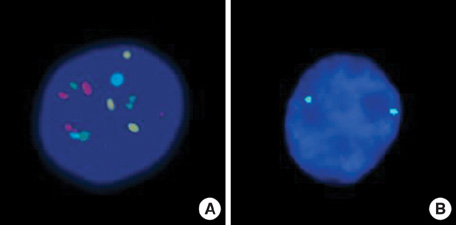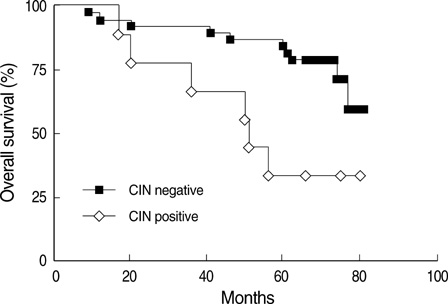J Korean Med Sci.
2010 Jun;25(6):863-867. 10.3346/jkms.2010.25.6.863.
The Relationship between the Presence of Chromosomal Instability and Prognosis of Squamous Cell Carcinoma of the Lung: Fluorescence in situ Hybridization Analysis of Paraffin-embedded Tissue from 47 Korean Patients
- Affiliations
-
- 1Department of Pulmonary and Critical Care Medicine, Asan Medical Center, College of Medicine, University of Ulsan, Seoul, Korea. ccm@ amc.seoul.kr
- 2Department of Pathology, Asan Medical Center, College of Medicine, University of Ulsan, Seoul, Korea.
- 3Department of Laboratory Medicine, College of Medicine, Seoul National University, Seoul, Korea.
- KMID: 2150864
- DOI: http://doi.org/10.3346/jkms.2010.25.6.863
Abstract
- To evaluate the prognostic importance of chromosomal instability (CIN) in squamous cell carcinoma (SCC) of the lung, the relationship between CIN detected by fluorescence in situ hybridization (FISH) and survival in SCC patients was examined. Forty-seven surgical specimens of lung SCC were analyzed. To identify tumors with CIN, p16 and multi-target DNA FISH assays for c-myc, chromosome 6, EGFR, and chromosome 5 (LAVysion, Vysis) were performed on nuclei extracted from paraffin-embedded tumor tissues. Survival rates were compared in terms of age, T factor, N factor, CIN, and smoking status. A sample was defined as CIN-positive if at least four of the five chromosomes were positive. Among the 47 specimens, 9 (19%) were CIN-positive. The overall survival rate was 66%. Overall survival rates were estimated as 33.3% for CIN-positive patients and 76.7% for CIN-negative patients (Hazard ratio 3.47; 95% Confidence interval, 1.25-9.67; P=0.017). In multivariate analysis, the presence of CIN was a predictive factor for survival. CIN-positive based on FISH can be prognostic factor of lung SCC.
Keyword
Figure
Reference
-
1. Braakhuis BJ, Tabor MP, Kummer JA, Leemans CR, Brakenhoff RH. A genetic explanation of Slaughter's concept of field cancerization: evidence and clinical implications. Cancer Res. 2003. 63:1727–1730.2. Masuda A, Takahashi T. Chromosome instability in human lung cancers: possible underlying mechanisms and potential consequences in the pathogenesis. Oncogene. 2002. 21:6884–6897.
Article3. Lengauer C, Kinzler KW, Vogelstein B. Genetic instabilities in human cancers. Nature. 1998. 396:643–649.
Article4. Nakamura H, Saji H, Idiris A, Hosaka M, Ogata A, Saijo T, Kato H. Chromosomal Instability Detected by Fluorescence in Situ Hybridization in Surgical Specimens of Non-Small Cell Lung Cancer Is Associated with Poor Survival. Clin Cancer Res. 2003. 9:2294–2299.5. Kang JU, Koo SH, Kwon KC, Park JW, Shin SY, Kim JM, Jung SS. High frequency of genetic alterations in non-small cell lung cancer detected by multi-target fluorescence in situ hybridization. J Korean Med Sci. 2007. 22:Suppl. S47–S51.
Article6. Choi CM, Seo KW, Jang SJ, Oh YM, Shim TS, Kim WS, Lee DS, Lee SD. Chromosomal instability is a risk factor for poor prognosis of adenocarcinoma of the lung: Fluorescence in situ hybridization analysis of paraffin-embedded tissue from Korean patients. Lung Cancer. 2008. 64:66–70.
Article7. Mountain CF. Revisions in the International System for Staging Lung Cancer. Chest. 1997. 111:1710–1717.
Article8. Stock C, Ambros IM, Lion T, Haas OA, Zoubek A, Gadner H, Ambros PF. Detection of numerical and structural chromosome abnormalities in pediatric germ cell tumors by means of interphase cytogenetics. Genes Chromosomes Cancer. 1994. 11:40–50.
Article9. Lee DY, Cho HI, Kang YH, Yun SS, Park SY, Lee YS, Kim Y, Lee DS. The role of fluorescence in situ hybridization (FISH) for monitoring hematologic malignancies with BCR/ABL or ETO/AML1 rearrangement: a comparative study with FISH and G-banding on 919 consecutive specimens of hematologic malignancies. Cancer Genet Cytogenet. 2004. 152:1–7.
Article10. Fonseca R, Barlogie B, Bataille R, Bastard C, Bergsagel PL, Chesi M, Davis FE, Drach J, Greipp PR, Kirsch IR, Kuehl WM, Hernandez JM, Minvielle S, Pilarski LM, Shaughnessy JD Jr, Stewart AK, Avet-Loiseau H. Genetics and cytogenetics of multiple myeloma: a workshop report. Cancer Res. 2004. 64:1546–1558.11. Pirozynski M. 100 years of lung cancer. Respir Med. 2006. 100:2073–2084.12. Taguchi T, Zhou JY, Feder M, Litwin S, Klein-Szanto AJ, Testa JR. Detection of aneuploidy in interphase nuclei from non-small cell lung carcinomas by fluorescence in situ hybridization using chromosome-specific repetitive DNA probes. Cancer Genet Cytogenet. 1996. 89:120–125.
Article13. Mendelin J, Grayson M, Wallis T, Visscher DW. Analysis of chromosome aneuploidy in breast carcinoma progression by using fluorescence in situ hybridization. Lab Invest. 1999. 79:387–393.14. Kwak KW, Kim SH, Lee HM. The utility of fluorescence in situ hybridization for detection of bladder urothelial carcinoma in routine clinical practice. J Korean Med Sci. 2009. 24:1139–1144.
Article15. Kim SR, Kim HJ, Kim SH. Clinical utility of fluorescence in-situ hybridization profile test in detecting genetic aberrations in acute leukemia. Korean J Lab Med. 2009. 29:371–378.
Article16. Yoon YS, Lee DS, Min HC, Jang JY, Lee SE, Hwang DW, Han HS, Kim SW. Analysis of molecular cytogenetics alteration of pancreatic cancer identified by fluorescent in situ hybridization (FISH) and its clinical significance. Korean J Hepatobiliary Pancreat Surg. 2008. 12:75–85.17. Bubendorf L, Müller P, Joos L, Grilli B, Vogel S, Herzog M, Barascud A, Feichter G, Dalquen P, Tamm M. Multitarget FISH analysis in the diagnosis of lung cancer. Am J Clin Pathol. 2005. 123:516–523.
Article18. Halling KC, Rickman OB, Kipp BR, Harwood AR, Doerr CH, Jett JR. A comparison of cytology and fluorescence in situ hybridization for the detection of lung cancer in bronchoscopic specimens. Chest. 2006. 130:694–701.
Article19. Jonsson S, Varella-Garcia M, Miller YE, Wolf HJ, Byers T, Braudrick S, Kiatsimkul P, Lewis M, Kennedy TC, Keith RL, Bjornsson J, McWilliams A, Lam S, Hirsch FR, Franklin WA. Chromosomal Aneusomy in Bronchial High-Grade Lesions Is Associated with Invasive Lung Cancer. Am J Respir Crit Care Med. 2008. 177:342–347.
Article20. Tseng RC, Hsieh FJ, Hsu HS, Wang YC. Minimal deletion regions in lung squamous cell carcinoma: Association with abnormality of the DNA double-strand break repair genes and their applications on gene identification and prognostic biomarkers. Lung Cancer. 2008. 59:332–339.
Article21. Yakut T, Schulten HJ, Demir A, Frank D, Danner B, Egeli U, Gebitekin C, Kahler E, Gunawan B, Urer N, Oztürk H, Füzesi L. Assessment of molecular events in squamous and non-squamous cell lung carcinoma. Lung Cancer. 2006. 54:293–301.
Article
- Full Text Links
- Actions
-
Cited
- CITED
-
- Close
- Share
- Similar articles
-
- Study on the Chromosome 13 and 17 of Prostatic Cancers by Fluorescence In Situ Hybridization Technique
- Detection of Numerical Chromosomal Aberration in Squamous Cell Carcinoma of the Lung by In Situ Hybridization Using #17 Centromeric Probes
- The Study for Chromosome 3p Loss in Renal Cell Carcinoma by Fluorescence in Situ Hybridization Using Paraffin-Embedded Tissue
- Analysis of Chromosomal Aberrations in Lung Cancer Cell Line, NCI-H1373
- Chromosomal instability in oral premalignancy



